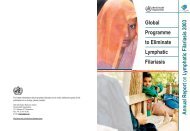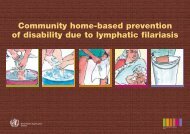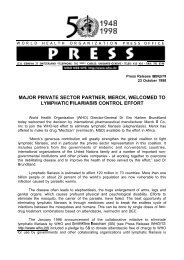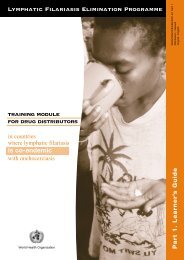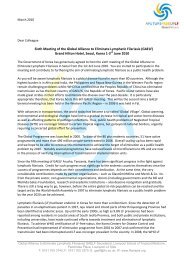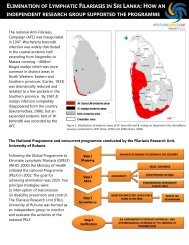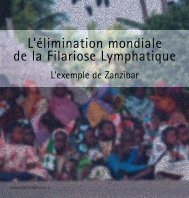English - Global Alliance to Eliminate Lymphatic Filariasis
English - Global Alliance to Eliminate Lymphatic Filariasis
English - Global Alliance to Eliminate Lymphatic Filariasis
You also want an ePaper? Increase the reach of your titles
YUMPU automatically turns print PDFs into web optimized ePapers that Google loves.
REPORT OF THE 6 TH GAELF MEETING, JUNE 2010<br />
of human resources, such as well-trained<br />
staff.<br />
Even with these challenges, however,<br />
MDA can be successful in such settings.<br />
For example, onchocerciasis programmes<br />
persisted and even expanded during<br />
periods of conflict in the Central African<br />
Republic, Sudan, and the Democratic<br />
Republic of the Congo.<br />
Lessons from these experiences include<br />
the importance of investing in<br />
communities, which can be quite resilient;<br />
the need for flexibility and mobility; the<br />
increased cost of doing business in zones<br />
of conflict; and the need for appropriate<br />
infrastructure (e.g., lap<strong>to</strong>p computers<br />
rather than desk<strong>to</strong>ps). With adherence <strong>to</strong><br />
these principles, MDA can be realistic for<br />
many areas in conflict.<br />
LF after MDA<br />
Dr Mwele Malecela noted that strategies<br />
for s<strong>to</strong>pping MDA and initiating post-MDA<br />
surveillance still need <strong>to</strong> be fine-tuned.<br />
However, the programmatic benefits of LF<br />
elimination will persist even after LF has<br />
been eliminated. Other NTDs will likely<br />
remain, and the infrastructure that was<br />
developed <strong>to</strong> eliminate LF can be<br />
transformed for use with other NTDs.<br />
Similarly, the benefits of strengthening<br />
the health system for LF elimination will<br />
persist. These benefits include human<br />
resources; controls and procedures for<br />
managing the drug inven<strong>to</strong>ry; recording<br />
and reporting systems; and cascade<br />
training programmes. Community-based<br />
distribu<strong>to</strong>rs trained for LF might well play<br />
a role as bona-fide health workers in an<br />
expanded health system.<br />
Morbidity management activities will<br />
continue, including patient support and<br />
advocacy groups and home-based health<br />
care for lymphoedema, preferably<br />
integrated with care for other noncommunicable<br />
diseases. The need for<br />
hydrocelec<strong>to</strong>my will continue, as will the<br />
need for psychological counselling (many<br />
men with hydrocele in the recent<br />
“hydrocelec<strong>to</strong>my camps” in Tanzania<br />
reported being suicidal). The President<br />
Kikwete Fund for hydrocele surgery was<br />
begun in response <strong>to</strong> awareness of the<br />
magnitude of the problem – more than<br />
15,000 affected men – which called for<br />
action.<br />
In conclusion, Dr Malecela reiterated that<br />
the patient remains central <strong>to</strong> the LF<br />
programme, and urged programme<br />
managers in the next decade <strong>to</strong> focus on<br />
surveillance.<br />
Discussion<br />
Several <strong>to</strong>pics were addressed in the<br />
discussion, including the advantages and<br />
disadvantages of using cellphones for<br />
surveillance, patient support groups,<br />
provision of mental health services, and<br />
timely notification of health workers<br />
regarding ADL episodes in patients with<br />
lymphoedema.<br />
37



